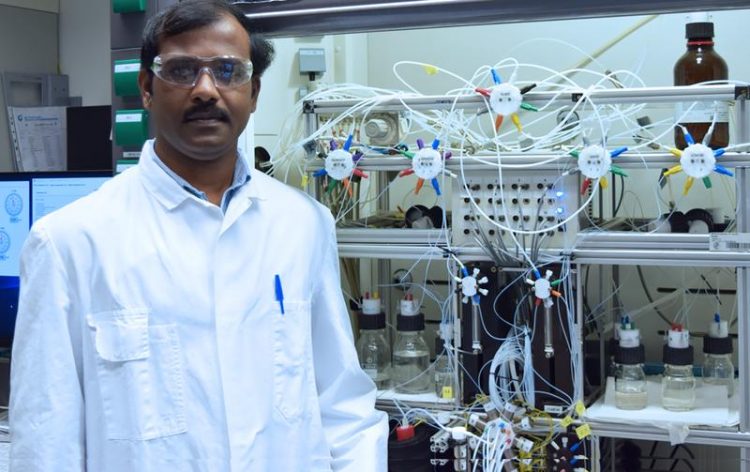Largest Synthetic Polysaccharide Assembled

Dr. Abragam Joseph in front of the home-built carbohydrate synthesis instrument. © Dr. Murty
Carbohydrates are the most dominant biopolymers on earth. Polysaccharides such as cellulose are the building materials for plants and shells of chitin protect animals. Even though Nature produces 100s of millions of tons of cellulose and chitin each year, access to completely defined polysaccharides has proven extremely difficult.
Synthetic chemists have in recent years attempted to prepare long polysaccharides from single building blocks. The group of Prof. Xin-Shan Ye (Peking University) set a new record in 2017 when a tremendous group effort produced a branched 92-mer.
Linear 100-mer polysaccharide within 188 hours
Now, two chemists, postdoctoral fellow Dr. Abragam Joseph and PhD student Alonso Pardo-Vargas in the team led by Peter H. Seeberger, Director at the Max Planck Institute of Colloids and Interfaces (Potsdam, Germany) used an automated synthesis instrument to prepare a linear 100-mer polysaccharide within 188 hours from one building block.
The team illustrated that polysaccharide chains prepared by the automated AGA method such as 30-mers and 31-mers can in turn be combined to form polysaccharides of unprecedented size and complexity as illustrated by the 31+30+30+30+30 coupling to form a multiply branched 151-mer.
Defined polysaccharides open up insights to all aspects of carbohydrates
Access to complex polysaccharides are the basis for investigations into fundamental structural processes such as carbohydrate folding that is not understood until today. The ability to quickly and reliably prepare such defined molecules gives scientists the tools to study all aspects of carbohydrates that have so far been impossible due to a lack of pure carbohydrates.
“Even two years ago, I would not have dared to dream that it would be possible to prepare 100- and even 150-mer polysaccharides. Systematic improvements in our chemical methods combined with better automated coupling protocols provide us now with extremely interesting tools to better understand carbohydrates” say Peter H. Seeberger who initiated and supervised the study.”
About the Max Planck Institute of Colloids and Interfaces
The Max Planck Institute of Colloids and Interfaces was founded in 1992 and is divided into four departments. The Biomolecuar Systems Department investigates chemistry and biology of carbohydrates and has developed automated glycan assembly since 2001.
Prof. Dr. Peter H. Seeberger
Director
Max-Planck-Institute of Colloids and Interfaces
Department of Biomolecular Systems
Am Mühlenberg 1
14476 Potsdam
Tel:: +49 (0) 331 – 567 – 9300
Peter.seeberger@mpikg.mpg.de
Joseph, A.; Pardo-Vargas, A.; Seeberger, P.H.; Total Synthesis of Polysaccharides by Automated Glycan Assembly; J. Am. Chem. Soc., 2020, 142, in press (https://doi.org/10.1021/jacs.0c00751)
Media Contact
All latest news from the category: Life Sciences and Chemistry
Articles and reports from the Life Sciences and chemistry area deal with applied and basic research into modern biology, chemistry and human medicine.
Valuable information can be found on a range of life sciences fields including bacteriology, biochemistry, bionics, bioinformatics, biophysics, biotechnology, genetics, geobotany, human biology, marine biology, microbiology, molecular biology, cellular biology, zoology, bioinorganic chemistry, microchemistry and environmental chemistry.
Newest articles

How marine worms regenerate lost body parts
The return of cells to a stem cell-like state as the key to regeneration. Many living organisms are able to regenerate damaged or lost tissue, but why some are particularly…

Nano-scale molecular detective
New on-chip device uses exotic light rays in 2D material to detect molecules. Researchers have developed a highly sensitive detector for identifying molecules via their infrared vibrational “fingerprint”. Published in Nature…

Novel CAR T-cell therapy
… demonstrates efficacy and safety in preclinical models of HER2-positive solid tumors. The p95HER2 protein is found expressed in one third of HER2+ tumors, which represent 4% of all tumors….



